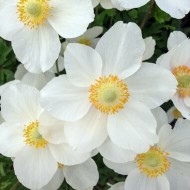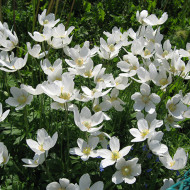Fragile and graceful anemone (anemone) forest in home gardening
Content
Description of forest anemones
Anemone is a perennial that grows outdoors. The popular name - anemone - it received due to the developed reaction of inflorescences to the wind.
The root system is strong and well developed. On the handle, gray-green leaves develop, the length of which is 15–20 cm. Flowering begins in late spring or early summer. On peduncles 2–3 white flowers.
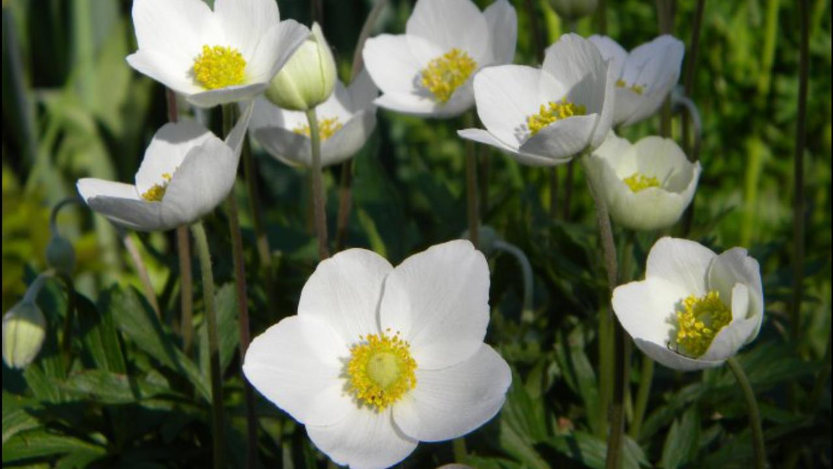
Their diameter is 6–8 cm. Flowering lasts three weeks and ends at the end of June. The anemone decorates the garden when the flowering of other crops has not yet begun. Under favorable weather conditions, re-flowering occurs in mid / late summer.
Places of growth in nature
In nature, there are about 180 species of anemones. They grow in the mountain ranges of the Caucasus, and in the cold regions of Siberia and even the Arctic. She adapts to different weather conditions. Anemone can grow like a weed on the side of roads and create powerful thickets in meadows. It is also found in shady forest areas. Flowers in plants growing in the wild usually do not exceed a diameter of 4–5 cm.
Video «Features of growing anemones»
From this video you will learn about the conditions for growing, planting and breeding wood anemone.
Useful and medicinal properties of the plant
Anemone has long been widely used in folk medicine. All parts of the plant are poisonous, but healers compose their recipes in such a way as to neutralize the dangerous effect on the body. It has antiseptic and antibacterial properties.

Most often it is used as a pain reliever. It is used to treat migraines, joint pain and back pain.
The analgesic effect of anemones is due to the content of narcotic substances in its leaves. They should be used with caution after consulting with specialists.
Decoctions with this plant were used to treat diseases of the respiratory system: asthma, bronchitis, whooping cough. It was used for pyelonephritis and cystitis, as it helps to remove fluid from the body. Also, anemone is used to correct potency and changes in the menstrual cycle.
Optimal conditions for home growing
It is not difficult to create optimal growing conditions for anemones. It is enough to study the peculiarities of its flowering in the wild and follow the advice of experienced gardeners.
Seat selection
For planting anemones, you should choose a well-shaded place. It can be planted in the shade of trees and bushes. If it is not possible to place the plant in such conditions, it is necessary to find an area that is shaded during the hot time of the day. After planting, it is necessary to keep the flower in the shade until it takes root.

The choice of moist soil is also important.Anemone grows on light sandy fertile soils and does not tolerate an acidic environment. If possible, it is better to choose a windless area and plant it next to mountain ash, spirea bushes, pansies.
Soil preparation
Before planting, the soil must be loosened to saturate it with oxygen. In order for the plant to feel good, peat and nitrogen fertilizers are applied to the ground.
If the soil is too heavy and contains a large amount of clay impurities, it must be thinned with sand. It is added to the hole before watering and planting. The addition of compost, ash and humus will have a beneficial effect on the growth and development of the plant.
Transplanting anemones
If the anemone grows next to other crops, it can grow and oppress them. To avoid this, it must be transplanted to the free places of the summer cottage.
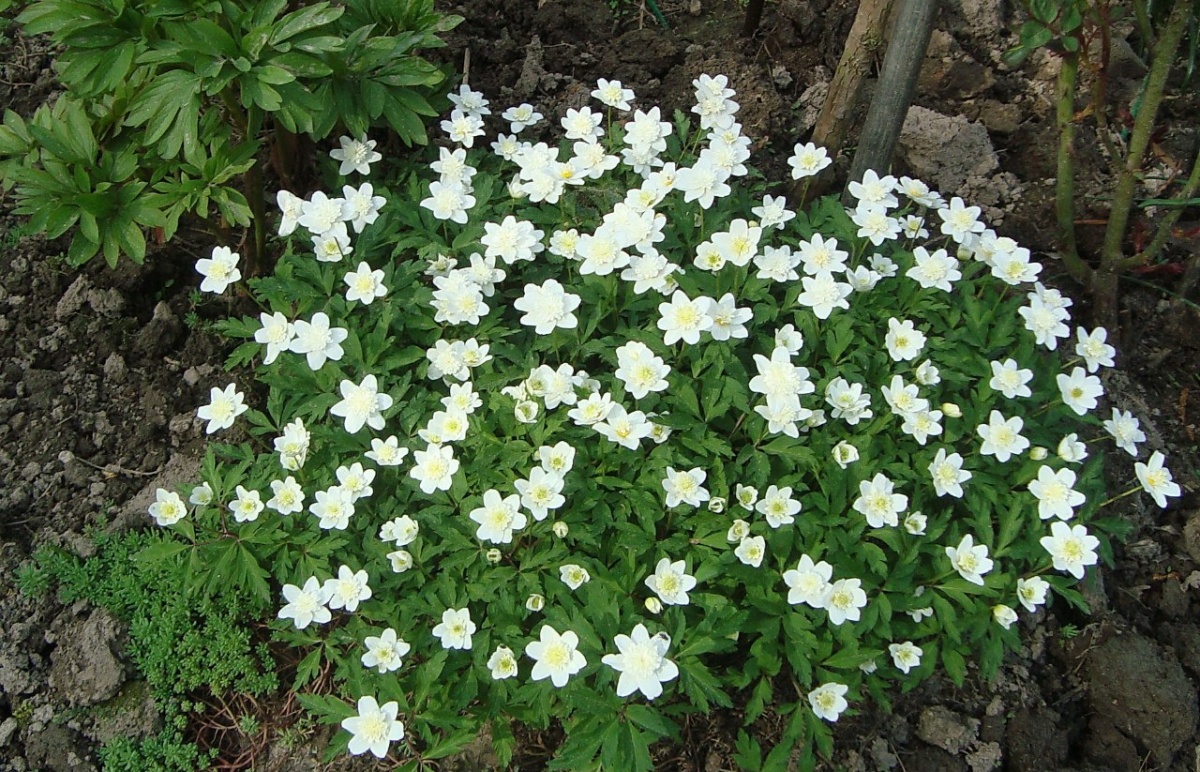
This procedure is carried out in the spring. The sprouts and root system are carefully dug out with a sharp spatula. The resulting bush is transferred to a new place with a large clod of earth. This will help to make the procedure as painless as possible. It is placed in a fertilized hole, covered with earth and watered abundantly. The plant must be protected from sunlight until it fully adapts to the new location.
Care rules
In order for the anemone to please with its abundant flowering and not get sick, it must be fertilized in time and properly prepared for winter.
Watering and fertilizing
In cool rainy weather, anemone does not require frequent watering. It should be moistened 1–2 times a week as the soil dries up. In hot weather conditions, it requires watering 1 time in 2–3 days. So that the plant does not suffer from drought, it is placed in shady places or artificial shading is created. It is also mulched with decayed foliage and shoots of cut garden plants.
Fertilizer for anemones is required only during flowering. It responds well to the application of organic fertilizers, humus and peat. It can also be fed with flowering plant supplements and nitrogen.
Plant pruning
The anemone reacts negatively to trimming any aerial parts. Peduncles are cut for bouquets, leaving at least one inflorescence.

It is important to prevent damage to the aerial parts of the anemone when trimming adjacent flowers or bushes. Even in autumn, leaves should be left to die off naturally. They dry up and fall away, and in the spring new shoots appear.
Preparing for winter
In the climatic conditions of the middle zone, the anemone does not require special preparation for winter. Most often, bushes are left with yellowed foliage, which serves as a natural shelter. If the temperature drops below –25 ° C, it can be covered with a 10 cm layer of mulch.
In the north, the rhizome is most often dug up. In this case, you must not damage the root system and remove leaves or peduncles. Excavated bushes are stored in a cool place where the temperature does not drop below –5 ° C. In the spring, they are planted in the ground after it has been warmed up.
Forest anemones propagation
Anemone lends itself well to reproduction. It can be propagated in different ways and used for sale and to decorate a large area of the summer cottage.
Seeds
In nature, anemone reproduces by self-dispersing. But under artificial conditions, seeds do not differ in germination. As a rule, only a quarter of the collected material germinates. Gardeners recommend subjecting it to low temperatures. This allows you to increase germination by up to 50%.
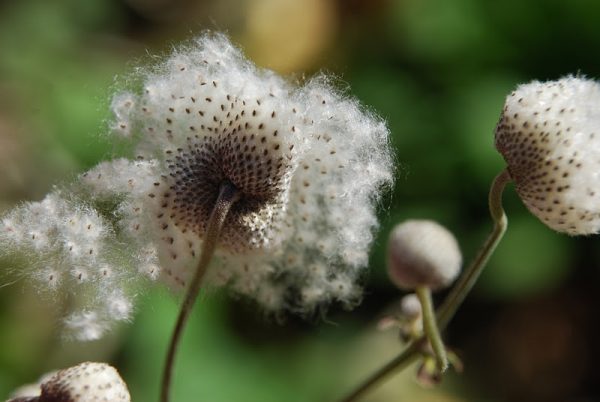
The seeds are sown in the middle of summer. They are sprinkled with a centimeter layer of earth and covered with a small layer of mulch.Shoots appear in early autumn and have time to get stronger before frost. During a cold snap, they are dug up and stored in the basement.
Tubers
Before planting the tubers, the anemones are soaked in warm water for 3–4 hours. Then they are placed in a tightly tied bag with Epin's solution for 6 hours, after which they begin to plant.
The depth of the planting pit is 15 cm. A peat substrate is introduced into it, where the planting material is placed. It can be sprinkled with ash and humus. Then the tubers are covered with earth, leaving a depression for watering. After that, the anemone is abundantly moisturized. Before shoots appear, it must be watered daily and the soil must not dry out.
Cuttings
Most often, anemone is propagated by cuttings. In autumn, three quarters of the planted bushes take root, with early planting – half.
For reproduction in this way, it is necessary to choose a strong healthy bush, dig it up and separate a small part of the roots. After that, the mother plant is returned to its place and watered abundantly. The resulting material is cut into pieces with a length of 5–7 cm and treated with Epin's solution. After that, the children are placed in pots with a peat-sandy substrate and watered regularly so that the soil does not dry out. Most often they are placed in a greenhouse to avoid temperature fluctuations.
After the emergence of shoots, the frequency of watering increases. When they get stronger, they can be taken out of the greenhouse or the greenhouse film can be removed. For the winter, flowers are placed in the basement, and in the spring they are planted from pots to flower beds.
Diseases and pests and methods of dealing with them
Anemone is resistant to parasites and diseases. Sometimes it can be affected by leaf nematodes. These worms feed on parts of the foliage of plants. When damaged, dry yellow spots appear on the leaves. After that, the bush stops blooming, gets sick and withers. To get rid of the pest, it is necessary to remove the damaged shoots. If most of the bush is affected, it is completely pulled out and burned to save healthy plants.
Anemone – a forest plant that attracts gardeners with its casual appearance and ease of growing. It will serve as a decoration for a bouquet and will add variety to a lush flower bed. And unpretentiousness will allow you to grow an anemone both in the arid south and in cold Siberia.

